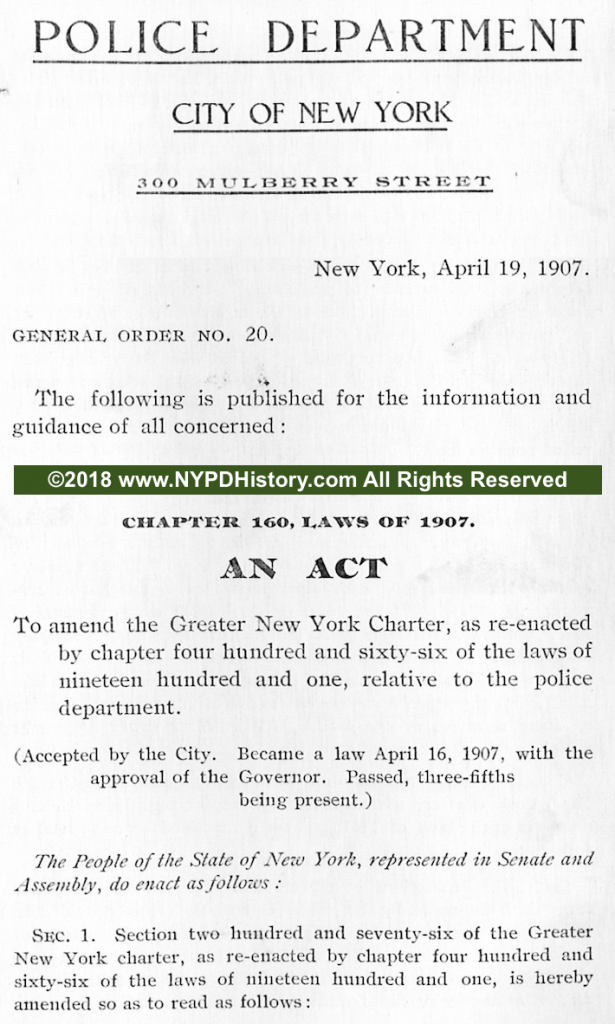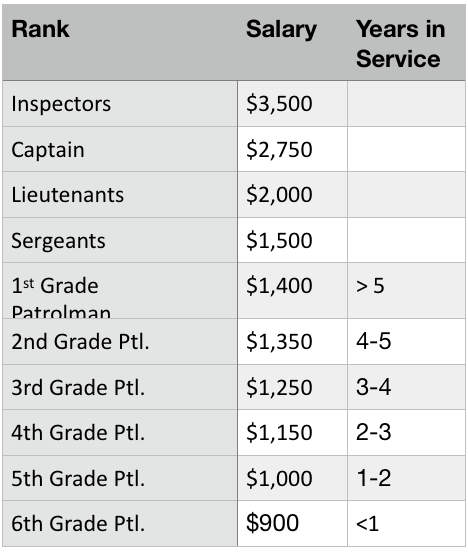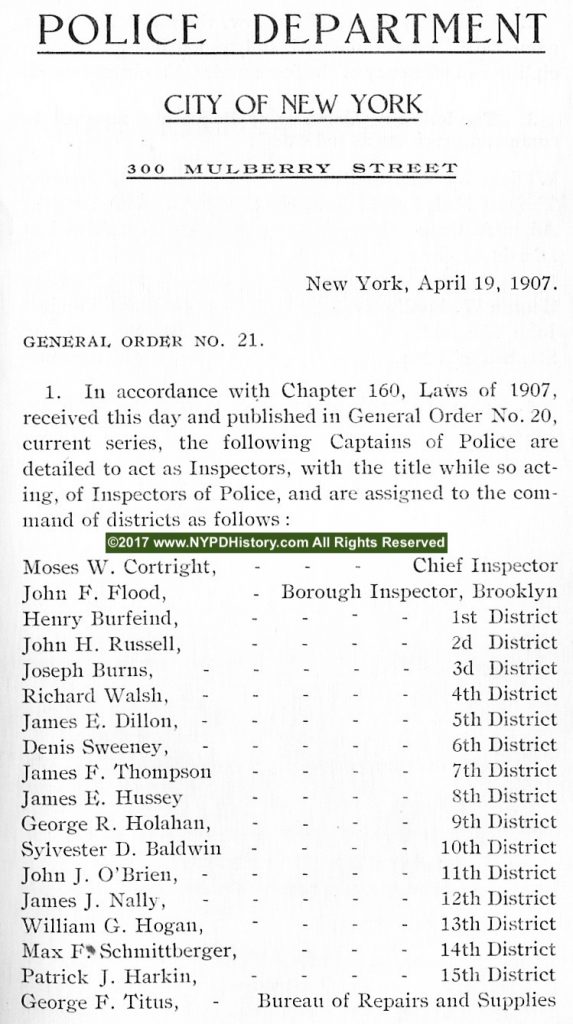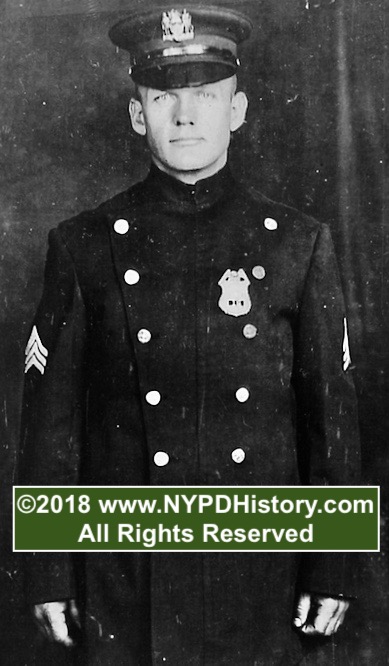

Introduction
For months, rumors that Police Commissioner (PC) Theodore A. Bingham (1906-1909) was working on an amendment to the Charter of Greater New York that would forever change the department spread from Police Headquarters, located at 300 Mulberry St., Manhattan. Within one week of April 20, 1907, a legislative bill passed in the New York State Capital at Albany and was signed into law. Word quickly reached New York City about the potential impact of the bills on the Police Department of the City of New York (PDNY or NYPD). One newspaper’s headline read “Police Shake-Up Coming Soon!” The bill was informally referred to as the “Bingham Police Bill” after PC Bingham. The eye of the storm had formed and the upheaval that played out over April 19th and 20th was remembered by generations of officers as “The Slaughter of April 1907.”
Based on the bill that amended the City Charter, on April 19, 1907, PC Bingham issued three General Orders (G.O.) which took effect on April 20th. On the evening of the 19th, a newspaper described the scene at headquarters as follows: “Police headquarters was a busy place…in the Detective Bureau, in the corridors, in Mulberry Street, and standing around the corners were hundreds of Lieutenants, Sergeants, and others who while waiting for orders formed what they called “The Know Nothing Squad.” Officers in outlying precincts received orders delivered by telephone directing them to report to headquarters “forthwith.”
Background
PC Bingham’s efforts were made due to his well-founded belief that the PC did not have enough control over the upper echelon of officers, particularly the Inspectors. PC Bingham’s concern was shared by the mayor, civic groups, and the public. The concern was that the politically-appointed Inspectors were the core of the systemic graft and corruption, and as a whole stood in the way of any direction by the PC. In essence, and practice, they and their corrupt political backers were referred to as “the system.”
One newspaper described the situation this way “Commissioners come and go every four years or less. But the cabal of Inspectors who make the system goes on forever, bending captains and sergeants to its will by reasons of the long tenure of the men who administer the system and the pressure which they can exert without the knowledge of the commissioner.”
PC Bingham had other concerns including: the inefficiency of the Central Office (Headquarters) Detective Bureau, the few Precinct Detectives who were under control of the precinct Captains, and the very rank structure of the department itself.
Prior to the Bingham Bill, the rank structure was (1904, for example): Patrolman, Roundsman, Sergeant, Detective Sergeant, Captain, Inspector, Chief Inspector. After the Bill, the rank structure was, and largely remains: Patrolman, Sergeant, Lieutenant, Captain, Inspector, Chief of Police. [Note: Today there are Deputy Inspectors, Deputy and Assistant Chiefs, Bureau Chiefs and Chief of Department, however, these are detailed ranks. With cause, any officer in rank above Captain may be demoted to Captain, the highest Civil Service rank, which emanates from the Bingham Bill.]
PC Bingham had a military background (he was a General) and wanted a military rank structure in the department. To accomplish what he wanted, a change to the NYC Charter would be required, and that meant that legislation by NYS was required.
Opposition to the Bingham Bill
The “system” fought the legislation as it threatened the system of graft that was permitted by the politically-backed inspectors who collected graft and ordered their men not to take enforcement action against certain bars, brothels and gambling houses.
One of the police organizations opposed to the bill was the Policemen’s Benevolent Association (PBA) which heavily lobbied Albany’s legislators. After an investigation conducted by New York County District Attorney William Travers Jerome and PC Bingham, investigators found $74,000 in cash belonging to the PBA in safety deposit boxes, and $8,000, wrapped in an old shirt, in the home of a Past-President of the PBA. The source of the money was a 1906 levy by the PBA of $20 per member, ostensibly for a “Mortuary Fund.” The $74,000 was kept in a vault near Grand Central Station “where the train starts for Albany.” The PBA lobbyists were known as the “Black Cavalry.”
The Liquor Dealers Association lobbied against the bill as did the corrupt Democrat Party institution that was “Tammany Hall.”
Proponents of the bill included several citizens groups including the “Citizen’s Police Committee of the New York Bureau of City Betterment for the Conduct of Research.” As providence would have it, the author of the report was Arthur Woods, who as a result of the Bingham Bill, would, pursuant to G.O. 43, dated July 24, 1907, be appointed Fourth Deputy Commissioner in charge of the newly formed Detective Bureau.
The Bingham Bill
Once the bill was signed by the Governor of New York State, PC Bingham promulgated a series of three General Orders based on the bill. Ranks were created and abolished. Some officers were promoted, others demoted. Men in the upper echelon of the department, who had received the order, reported to headquarters to learn their fate. Few men were spared. Those that “took a hit” were eight Inspectors and “unnumbered” Detective Sergeants in the Central Office’s Detective Bureau, who had recently been granted the rank of Lieutenant under a new law.
Inspectors, who supervised Captains in more than one adjoined precinct, were reduced to the rank of Captain and assigned as Commanding Officers of a single precinct. The Lieutenants, who were previously Detective Sergeants, were removed from the centralized Detective Bureau and cast about to precincts throughout the city. The Police Inspectors’ Association of the City of New York feared the loss of the permanency of the rank.
The Inspectors who were demoted and transferred were a veritable “Who’s Who” of the turn of the century department. As remains the practice to this day, the transfers were punitive in that they sent the transferee from one part of the city (generally located near their residence) to a precinct far away from their residence. Remember that public transportation amounted to the limited subway lines (the subway first opened in 1904), horse-drawn and mechanized omnibuses, ferries, and various other means powered by the horses or engines. The only bridge crossing the East River was the New York and Brooklyn Bridge.
The Series of Orders

The three General Orders issued on April 19, 1907, were as follows:
General Order 20 – Entitled An Amendment to the Greater New York Charter, as re-enacted by Chapter 466 of the Laws of 1901, relative to the NYPD.
[Note: Text in yellow reflects the verbiage of the G.O. Text in white are the author’s comments on the same.]
In sum and substance, G.O. 20 promulgated the directives:
That for the total number of men on the force (7,839) there be one Captain (maximum of 150), four Lieutenants, and four Sergeants per every fifty Patrolmen (except in the “rural parts of the city”) “in addition to the number detailed to act as Inspectors, as hereinafter provided.”
That the Deputy Chiefs “who shall have been in said office prior to” April 22, 1901, “shall become captains of police, with the salaries of deputy chiefs, and the rights granted to deputy chiefs with respect to the relief pension fund.”
That “the rank or grade of inspector of police is hereby abolished and the inspectors of police who hold such office…shall become captains.”
Prior to the passage of the Bingham Bill, the rank of Inspector was a product of civil service.
That “those members of the police force who have heretofore been designated as sergeants…shall hereafter be designated as lieutenants.”
Acts of meritorious service performed by a candidate for promotion were to be considered by the civil service commission by way of points added to the candidates examination score.
That Sergeants were to be promoted from patrolmen and only demoted to Patrolman “after due trial upon charges;” that Lieutenants were to be selected from sergeants with two years in title and may be similarly reduced to previous rank; and that Captains were to be selected from lieutenants who had three years in title.
That the PC had the discretion to select nineteen Captains to serve as Inspectors at a salary of an additional $750 per annum, “and at his pleasure may revoke any or all such details.” (New to the law.)
This part of the bill was viewed as a blow to the “system” which took advantage of the appointment of a man to the rank of Inspector by holding the recipient hostage to those politicians that placed him in the rank. With the detail to the rank of Inspector now at the discretion of the PC, the influence of politically appointed Inspectors was broken.
That “the central office bureau of detectives” and “the rank or grade of detective sergeant…are hereby abolished. But the persons holding the position of detective sergeants when this act takes effect shall remain members of the force with the rank of lieutenants of police.”
That the PC “shall organize and maintain a bureau for detective purposes to be known as the detective bureau;” that the PC may detail, and revoke the detail of, any number of men to the bureau as he may deem necessary.
Prior to the passage of the Bingham Bill, the rank of Detective was a product of civil service.
That the Commanding Officer of the Detective Bureau receive the salary of a Captain; that 150 men be detailed to the new grade of “First Grade Detective” with a salary equal to that of Lieutenant; that the bureau operate out of headquarters; and that a branch office be established in Brooklyn, with others established when deemed necessary elsewhere.
G.O. 20 set forth ranks and salaries as follows:

General Order 21 – Pursuant to Chapter 160 of the Laws of 1907, set forth:
That “Captains of Police are detailed to act as Inspectors with the title while so acting, of Inspectors of Police”…are ‘chargeable with and responsible for the discipline and efficiency of the force’ under their command”…”and are assigned to command of districts as follows.”

By September 1908, the hierarchy of detailed Captains included Chief Inspector, Borough Inspector, District Inspector, and Inspector.
General Order 22 – Pursuant to Chapter 160 of the Laws of 1907, Relating to Detectives , set forth:
“That members of the Police Force doing detective duty at 8 p.m., on April 19, 1907 will continue on such duty until further orders, except as otherwise provided in this and other orders.”
That “Lieutenant James McCafferty is temporarily assigned to command the Detective Bureau, and will report forthwith to the Police Commissioner for instructions.”
It was necessary for McCafferty to be promoted to Captain before he could be made Acting Inspector and continue to serve as Commanding Officer of the new Detective Bureau.
McCafferty replaced William W. McLaughlin, who had long served as “Chief of Detectives.” McLaughlin was transferred to the 38th Precinct, known as the “Westchester Precinct” because it was in the former Village of Westchester, in the County of Westchester, prior to annexation by New York City in 1895. A transfer to a Bronx precinct was said to have cast the man “among the goats.”
Another Inspector who was demoted to Captain was transferred from his district at Coney Island, Brooklyn to command a precinct at City Island, the Bronx. City Island was described by one newspaper as “one of the suburban places whence Captains have been wont to retreat to eat humble pie.”
The order then remanded to uniformed duty twenty-seven Lieutenants who were previously assigned to Detective work as well as six Patrolmen.
The order then detailed four Lieutenants, one Sergeant, and eleven Patrolmen from uniformed patrol to the Detective Bureau.
Uniform, Emblem and Insignia Changes
The new Lieutenants wore a single gold gilt bar on their sleeve and collar. In May 1907, new shields for Lieutenants and Detectives were issued. The shields for Lieutenants had a large panel bearing the shield number of the officer. Richard E. Enright, President of the LBA, fought to have the numerals removed and won. The resulting starburst design, absent any numerals, remains to this day. The Detectives’ shield changed slightly over time, but the original style remains largely unchanged .
Pursuant to General Order 23, issued on April 23, 1907, the new Sergeants wore three chevrons on their sleeve. New Shields for Sergeants were ordered. The style remains largely unchanged.



Summary
What’s the Deal with: The Present Rank Structure in the NYPD? Prior to his appointment, PC Bingham had been an outside observer of the department. After his appointment, he concluded that the PC had little or no control over the politically-appointed Inspectors, whose titles were permanent, and that the longstanding systemic graft and corruption could not be broken unless the PC could select, detail and demote Inspectors.
PC Bingham also determined that the Central Office Detective Bureau was inefficient as were, largely, the few Precinct Detectives. By abolishing the Bureau and re-establishing a Detective Bureau, PC Bingham “re-booted” the Bureau and selected capable men who served as detailed Patrolmen. Additionally, he created the title of First Grade Detective.
One by one, the long-serving Inspectors would retire and more detailed Captains to that rank replaced them. It appeared that PC Bingham had found the “Achilles Heal” of the system and had broken it.
The present rank structure is based wholly on that instituted by PC Theodore A. Bingham, by way of the Bingham Bill and three General Orders, all issued on April 19, 1907, which shook the department to its core. The effects of the wholesale changes made April 20, 1907 were in the minds of the officers, a day long remembered as “The Slaughter of April 1907.”
The Author has selected relevant excerpts from the 1908 Rules & Regulations of the Police Department of the City of New York, issued on September 24, 1908 which are relevant to the aforementioned article. For those interested in learning how the changes made by the Bingham Bill were reflected in the Rules & Regs. Click Here -> 1908 Rules & Regs <- A .pdf format document which will open in another browser window.
As is the case will all of his posts, the Author welcomes input, corrections, suggested clarifications, and constructive criticism.
The Author can be contacted by email at
![]()



Leave a Reply
You must be logged in to post a comment.